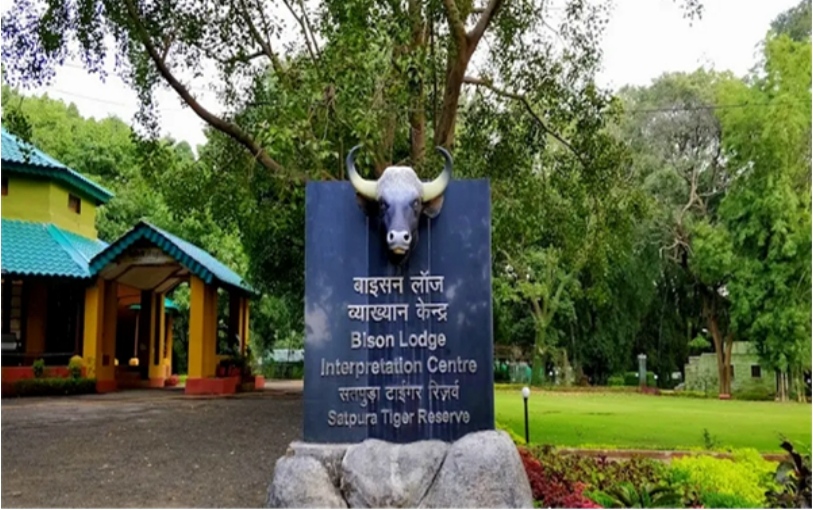The Call of Madhai: Satpura Tiger Reserve
“Tiger tracks….follow them long enough & you will eventually arrive at a tiger, unless the tiger arrives at you first”….. A Satpura tiger reserve signage

By
COL SATISH SINGH LALOTRA
The subcontinent of ours placed in a unique position geographically in the Asian subcontinent, is besotted with myriad flora and fauna placing it atop the best of ecological zones of the world. Such a wide latitude in flora and fauna is available in India that even today a major part of them are left undiscovered, keeping the best of conservationists guessing and on their toes to catalogue them with all the sincerity they deserve.With a total of 104 national parks & 566 wild life sanctuaries to boast of, I suppose India stands first among equals in the comity of nations in the world towards flora& fauna conservation.
Madhya Pradesh in the country ranks first in housing maximum number of national parks/wild life sanctuaries. Having a long history of conservation in India “Madhai” and “Bori” pride itself in being one of the oldest wildlife sanctuaries in the country.Declared as a reserve forest in 1857, it was notified as a wild life sanctuary in 1975 and a national park in 1982.
Exactly a decade back in December 2011, I had the unique opportunity to explore the entire environs of “Madhai- Satpura tiger reserve” posted at CPE, Itarsi (DGQA) in Madhya Pradesh while still in service. It took a few telephone calls from my establishment to fix up our rendezvous with one of the best kept nature conservation centers in India. Satpura Mountains are the highest mountain ranges in central India. Covered by dense foliage they are home to more wild life species than any other forest in the country. This includes the tiger, the giant squirrel, sambhar, spotted deer, chinkara, Crocodile, wild boars, leopards, wild dogs, barking deer, dangerous snakes like rock python, giant scorpions to name a few.
The Satpura tiger reserve which occupies a major portion of these forests and mountains is surrounded on two sides by the backwaters of the “Tawa dam”. Its major rivers like Tawa, Denwa, Malini, Bori, Sonbhadra, and Nagdwariare flooded with these backwaters and all are home to thousands of rare migratory birds from all corners of the world. Reputed to be older than the Himalayas as mentioned earlier in this write up, it is for this reason that humans have inhabited them since times immemorial. Satpuras are not just forests in their length and breadth but hold centuries of mysteries yet undiscovered, folklore and stories untold.
Our(self & family) sojourn with Madhai (Satpura) tiger reserve included a wide circuit of movement to include Pachmarhi also known as the “Queen of Satpura hills” via Hoshangabad as a small halt to partake in the viewing of famous cocoon breeding centers at Malakhedi the brand ambassador of “MP Silk federation”. Among the famous folklore doing rounds in Satpura is the story of the king of Satpura, Raja Bhabhut singh who along with his men died fighting for these forests against the British forces in the 1st war of independence in 1857. It was after this action that the British vacated the tribals from this land in the mountains and declared Bori sanctuary as the first reserve forest in India in the name of conservation but started cutting the forest as a supply zone to supply teakwood to the colonial establishment.
Having kick started from my establishment at Itarsi early morning, I skipped the brief halt at cocoon breeding center Malakhedi, Hoshangabad since it seemed I had packed too many places and people in my itinerary to do justice to my actual destination at the STR (Satpura tiger reserve), preferring to visit the former at some other convenient time. The nearest railway station near Madhai are Sohagpur(26.9 kms), Piparia (40 kms), Hoshangabad(60 kms), whereas by road Madhai varies in distance from Bhopal (130kms), to 310 kms from places like Nagpur and 200kms plus from cities like Sagaur, and Jabalpur.
We logged in the official visitor’s book kept at FRH (Forest rest house)Madhai at about 10 am after having crossed the famous Denva river in a speed boat which abuts the entrance of Madhai tiger reserve from Hoashangbad side. The FRH, Madhai offers an excellent opportunity for a wanderlust to stretch his legs a bit before taking on the jungle safari deep inside the STR-Satpura tiger reserve.One can book his/her jeep/gypsy for the jungle safari either from the crossing point at R. Denva or from FRH Madhai both of which have a MP Tourism outlet to do the needful.
All these facilities are maintained in an absolute ship shape condition by the STR establishment along with the forest guides most of them from being Korku tribewho know the area by the back of their hands and can be hired on payment for very reasonable fees. Since I had a korku boy as my helper at CPE Itarsi, it helped matters very much in gelling up with the forest guide to take us over the rough and tumble of the tiger reserve. Madhai is in fact a breathtaking creation of nature in its entire splendor. Once you are on the trail of the tiger reserve the verdant forests open up in front of you in all its greenery.
The green canopy of the Sal trees meets your eyes with fancy blue patches of the sky showing through the openings. As your eyes wander downwards on the ground, grassland shrubs harbour half hidden from your view chital, Gaur and Sambar. Even if you do not see a tiger, probably a tiger has seen you as you drive through the forest. The emerald green meadows, valleys densely wooded with thick growth of sal and teak, hill slopes covered with mixed forests of Saja, Bija, tendu and bamboo are a regular feature in this part of central India. Streams crisscross the terrain and R.Denwameanders along the Madhai forests in all its glory.
As a jewel in the heart of central India high lands, Satpura tiger reserve lies nestled in the Mahadeo ranges of Satpura range. District Hoshangabad of MP near Pachmarhi has the unique distinction of having this nature’s paradise in the form of STR in itsprecincts. The area forms part of the largest remaining contiguous forest in India. This area is also outstanding in its rich biodiversity and for many years has been a paradise for both botanical & zoological scientists. The nature of the terrain which is both rugged and largely difficult to access has afforded the area a significant degree of natural protection. The variety of altitude, slopes and rainfall give rise to rich and luxuriant vegetation which is among the most noteworthy in India. Both the principal timber trees of India i.e. the north Indian Sal and the south Indian teak are found in this area. Also present as mentioned earlier are bamboo and miscellaneous forests with a rich variety of ferns including tree ferns, Bryophytes & other plant groups.
In addition to the above trees like Palas whose flowers streak the forest with a vermillion hue in month of March and Jamun whose fruits are relished by one and all are in abundance over here. The area also contains a large number of rare and endemic plants like Bryophytes, Pterdiophytes like Psilotum, Cythia, Osmunda, Lycopodium, and Lygodiumetcthat must be protected from extinction. A look at these Bryophytes & Pteridophytes in abundance in Madhai took me back to my B.sc botany classes while doing my graduation at Govt College Udhampur in the early 80s where they used to be preserved in the formaldehyde solution in the laboratories.
It is interesting to note that that some species which are not common elsewhere in MP are found in this area for example Malastoma, Maraya Paniculata, Blumia, Lance Laria etc. All these names in their botanical nomenclature were rattled out to me by my Korku guide who was accompanying us in our gypsy from FRH Madhai. It is really amazing to find how a Korku tribal can remember such tongue twisting names. It is all in the name of survival of his service which forms part of his training as imparted by the STR to woo the tourists in abundance.
Madhai is also famous for the world renowned Indian bison known as “Gaur” and has a dedicated “interpretation center” in Pachmarhi town known as the ‘Bison lodge”. Named after Capt Forsyth of British Indian army in 1862 he used this area to survey and explore the forests of central India for its usage for the colonial army. The ‘Bison lodge” is now an accomplished museum cum interpretation center as part of STR and located in Pachmarhi town. Though I had gone in the month of December to Madhai when the weather was cold and conducive for sighting of tigers who venture out of deep ravines and their lairs to laze around in the sun in the open areas, was not lucky to spot even one.The saving grace was a Sambar which we spotted doing alarming calls standing next to a forest trail indicating that a carnivore was lurking nearby. Leaving aside this event off course our Korku guide took us near to a huge Bison herd in total peace with themselves grazing around. Besides above we were lucky in spotting Crocodiles with their bodies half immersed in streams across the Madhai, and a fast paced pack of wild dogs chasing a chital in the tall sarkanda grass.
Meticulous efforts go into keeping Madhai in its pristine form. Ever vigilant staff is posted at strategically located forest camps that patrol the forests day in and out in the scorching heat of central India, chilling winters of December /January and in the lashing of the monsoons to ensure the safety of the wildlife and of its habitat against poachers, and intruders. But what goes behind in making Madhai as one of the best kept tiger reserves in the country can only be known when one interacts with the supporting as well as management staff over there.




